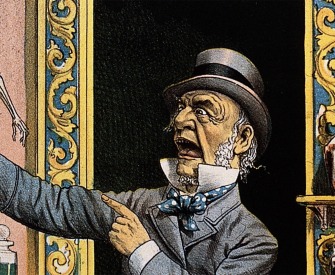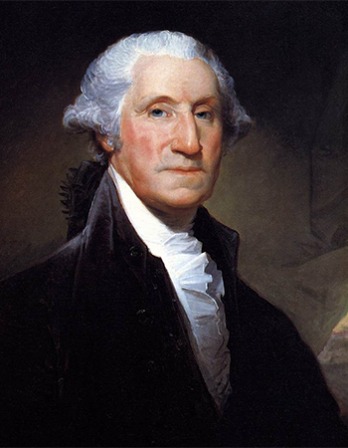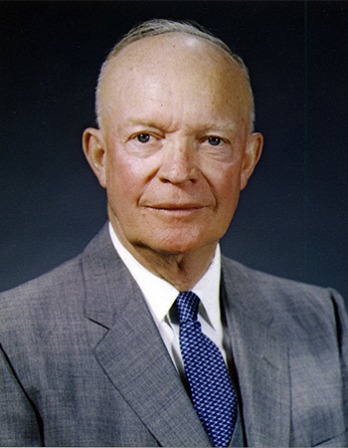One is never as unhappy as one thinks, nor as happy as one hopes.
Happiness
Government Work
Could a Ministry of Happiness improve the lives of India’s citizens?
By Maddy Crowell

Radha and Krishna Walk in a Flowering Grove, by the Kota Master, c. 1720. The Metropolitan Museum of Art, Cynthia Hazen Polsky and Leon B. Polsky Fund, 2003.
Reporting for this story was supported by the Pulitzer Center on Crisis Reporting.
In the summer of 2016, a dizzying photograph from Chennai, in the Indian state of Tamil Nadu, circulated through international media outlets. The photo shows about a thousand Indian schoolchildren dressed in white and blue uniforms, their bodies arranged in rows of twos and fours and fives, their arms clasped in acute triangles above their heads. on the ground, there must have been pandemonium: young children, fatigued by the scorching June heat, confused by what they were doing or why they were being told to stand still. But from above, an aerial camera caught the shot, decoding the labyrinthine mess of blazing, colorful bodies as they spelled out a message: keep smiling.
The shoot served as both the debut of—and, in its grandstanding way, a metaphor for—the Indian government’s latest addition to its sprawling bureaucracy: the Ministry of Happiness. Initially launched in the landlocked state of Madhya Pradesh, the ministry was set up, in the words preferred by Prime Minister Narendra Modi, to “put a smile on every face” in one of India’s most impoverished provinces. The state is best known for its tiger sanctuaries, its high farmer-suicide rates, and the Bhopal gas leak in 1984 that exposed at least half a million people to a highly toxic gas—still considered the world’s worst industrial disaster. “It matters how happy people are in Madhya Pradesh,” promised a government blog post that featured an image of an Indian family of four ensconced in a cheery bear hug. “Therefore, Madhya Pradesh government is ready to take on the worries of its citizens and bring cheers to the life of common man.”
The new initiative was first announced by India’s right-wing Hindu nationalist Bharatiya Janata Party (BJP) at a state executive meeting in its Bhopal headquarters in April 2016. “The state will be made responsible for the happiness and tolerance of its citizens,” declared Shivraj Singh Chouhan, the former chief minister of Madhya Pradesh and a BJP-celebrated yoga enthusiast. “We will rope in psychologists to counsel people on how to always be happy.” They decided on a budget of $567,000 and a purpose. “Happiness will not come into the lives of people merely with materialistic possessions or development,” Chouhan explained, “but by infusing positivity in their lives so that they don’t take extreme steps like suicide in distress.”
The following January, India’s first-ever “happiness minister” was appointed: the fifty-two-year-old Lal Singh Arya, a heavyset man who keeps a walrus mustache curled over his top lip and is often photographed in a simple tan sleeveless kurta over a white blouse. Combining more than seventy social programs across the state—from yoga practices to meditation to festivals—the Happiness Ministry would focus on “improving” the “four pillars” of society: good governance, sustainable socioeconomic development, cultural preservation, and environmental conservation. That is, happiness was to be delivered by adding further bureaucracy to a country consistently rated as having one of the most bloated and corrupt bureaucratic systems in Asia.
Media outlets around the world responded to the ministry’s launch mostly with bemusement, not just a little bit condescending. A headline in the Irish Times read: all smiles at the new ministry of happiness. An article by the BBC followed the launch of the first (and possibly only) happiness program the ministry actually executed: a full week of government-sponsored programs designed to “spread cheer.” Photos included children playing tug-of-war, competing in Bollywood dance competitions, and racing with their hands tied behind their backs to eat a string of sugary jalebis, a fried South Asian dessert. More than 25,000 “happiness volunteers” were reportedly recruited for the program, although the only evidence of their existence was in the form of media hype—what they were actually volunteering for remained unclear.
Further propaganda did not provide clarity. The central Indian government set a budget of $735,000—more money than it had allocated for the ministry itself—to produce an anand (happiness) calendar, which Chouhan presented to Prime Minister Modi in New Delhi. The calendar was described as a “self-help manual,” with months divided into happiness themes. February, for example, is the month of “Pause.”
“We suffer mental exhaustion more often than physical fatigue,” the calendar relates. “Unknown fears, imaginary suspicions, disturbing thoughts, negative emotions keep the mind ceaselessly busy. Pause and look at this situation within.” Each day of the month is allocated a blank space, waiting to be checkmarked with daily accomplishments, including:
1. Pause. Observe silence for a few minutes every day.
2. Just sit still doing nothing.
3. Remember that you are mortal.
4. Chant a mantra during pause.
5. Visualize the sight of a calm lakeside and enjoy the sight.
The media blitz, the press photos, the public speeches, the calendar, the government’s promises—none of these really answered a central question: Was the ministry a sincere effort? Or was it merely a marketing campaign, an attempt to project the image of a happy country without actually addressing the concrete problems—food insecurity, homelessness, joblessness, violence, and uncompromising gender roles—that tend to hold most Indians back from pursuing happiness in their own way?
The answer may lie in a truth unmentioned in any of the materials, which would seem to reveal goals far less than Ayurvedic: not long before the ministry’s announcement, the nation had dropped several rankings in the annual UN-produced World Happiness Index. India—home of contemplation, birthplace of yoga—had been rated one of the least happy countries in the world.
It was the Kingdom of Bhutan, a remote country in the Himalayas, which in the twentieth century first introduced the idea that a government could—and should—be officially involved in its citizens’ happiness. In 1972, King Jigme Singye Wangchuck declared, “Gross national happiness is more important than gross domestic product” and created a Gross National Happiness Index, which acts like a political barometer, slumping when social or political ills overwhelm. For over thirty years, while other countries flexed their muscles based on GDP, Bhutan quietly put out its happiness numbers, which were calculated by surveying samples of its population with such questions as: How often do you recite prayers or meditate? How satisfied are you with your relationship with your family? How free do you feel to express your ideas?
The idea of a Gross National Happiness Index remained mostly foreign to the West until 2008, when French president Nicolas Sarkozy commissioned economists Joseph E. Stiglitz, Amartya Sen, and Jean-Paul Fitoussi to study how useful it would be to consider happiness when developing global indexes. Three years later the UN General Assembly convened to discuss a new resolution based on that study. That resolution was 65/309, or “Happiness: Toward a Holistic Approach to Development,” and its premise was, in theory, blithely simple. “The pursuit of happiness is a fundamental human goal,” the report states. “The gross domestic product indicator by nature was not designed to and does not adequately reflect the happiness and well-being of people.” Countries, in turn, should mold their public policy to reflect their citizens’ happiness—and move away from the vastly more popular measurement of commercial success.
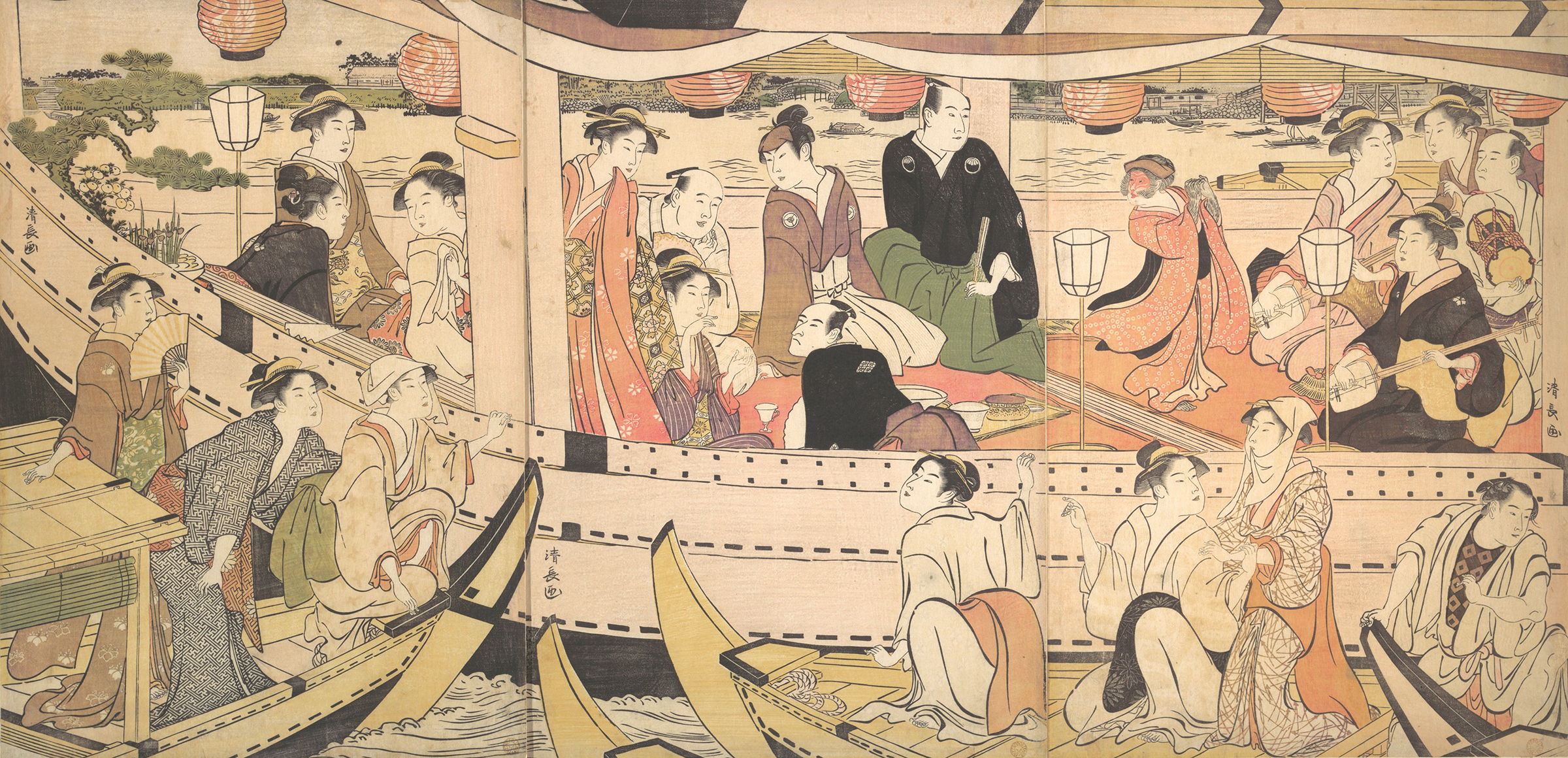
Pleasure Boat on the Sumida River, by Torii Kiyonaga, c. 1788. The Metropolitan Museum of Art, Rogers Fund, 1914.
One of the results of Resolution 65/309 has been the annual World Happiness Report, the country-by-country ranking of national happiness on which India had fallen toward the bottom. one hundred and fifty-six countries are evaluated based on variables proved to better one’s life, a sort of Maslow’s hierarchy manual for politicians: income, life expectancy, social support, freedom, trust, and generosity. As Jeffrey Sachs, the coauthor of the report, put it, “Asking people whether they are happy, or satisfied with their lives, offers important information about the society. It can signal underlying crises or hidden strengths. It can suggest the need for change.”
To most of humanity, the World Happiness Report has been treated as a midquarter report card—useful, and just as usefully ignored. But some countries—often not very democratic ones, it may be worth noting—have prioritized moving up in the rankings. There was the Venezuela’s cruelly ironic Ministry of Supreme Social Happiness, established just before a bloody uprising in 2014 to implement an umbrella of new social programs. (It’s not going very well.) There is the United Arab Emirates’ robust Ministry of Happiness and Well-Being, designed to “align and drive government policy to create social good and satisfaction.” (Two years later, Emirati princess Latifa outed her father in a video released to the world, accusing him of killing his enemies and of imprisoning his daughters.) There was Nigeria’s Ministry of Happiness and Purpose Fulfillment, in the state of Imo, which aimed to “reduce the costs in skilling employees and improve the employability of young people.” (It got off to a bad start when the governor of Imo appointed his sister as head of the department.) And then—after India slipped seven places from its original ranking of 111 in 2013, and it was noted by Indian media that Pakistan ranked higher—the country created its ministry.
On the surface, the devotion of government resources to happiness could be seen as a noble step toward refocusing society’s attention toward a more holistic practice of living. The fact that so many governments have created happiness ministries indicates a grasp, however cynical, of the need to radically reorient their societies. The very attempt to refocus the metrics away from money and material success may seem like a viable step toward figuring out what should replace it. Yet however much of their plans diverge from the original intentions of the Happiness Index, the problem with many of the ministries is not their focus on inner peace. The problem, rather, is that what seems to be causing most of the unhappiness in these countries is the government itself.
The peculiar ensemble of lofty abstractions that recasts government objectives in the light of mass emotional goals has all the markings of a Sisyphean task doomed to fail from the start. But in the case of India, there is at least one major consideration to support the effort: its own history as the birthplace of contemplative practices, commonly referred to today as “mindfulness” or “wellness.” Chouhan emphasized this in his original announcement of the ministry: while “normally happiness is measured with economic growth rate,” he said, such a relationship “is not entirely correct” in India, which “for ages believed otherwise.”
For thousands of years, India’s philosophers have focused on studies of both sukha (pleasure) and dokkha (pain). To live a balanced life, in Hinduism, was to experience both with a sense of equanimity. Between 1500 bc and 700 bc, the Vedic scriptures were composed, codifying aspects of this philosophy to form some of the earliest Ayurvedic practices—a catchall term for healing that in Sanskrit translates to “the science of life.” Fundamental to Ayurveda are the three doshas, or energies—vata, pitta, and kapha—which are said to form the inner balance in every person. “In India, ultimately the idea of happiness and well-being is considered intrinsic to human nature,” Kiran Kumar Salagame, a professor of psychology at the University of Mysore, told me. “You have it within you. It is a state of pure consciousness, of transcendental awareness.”
Under British colonial rule—which officially lasted from 1858 to 1947 but had been preceded by centuries of European control and influence in the region—such beliefs were derided and diminished. The idea that some concealed transcendent consciousness was floating invisibly in the ether of the physical world, and was a gateway for inner peace, was often cast as inferior to the Western scientific idea that what existed was that which could be measured. While to Indians some practices like yoga and meditation were seen as paths to this higher state, the British attempted to write off many of these ideas as “crazy superstition,” Salagame explained to me. “Under colonialism, the Indian mind was subjugated: it was told, ‘It’s all nonsense.’ ”
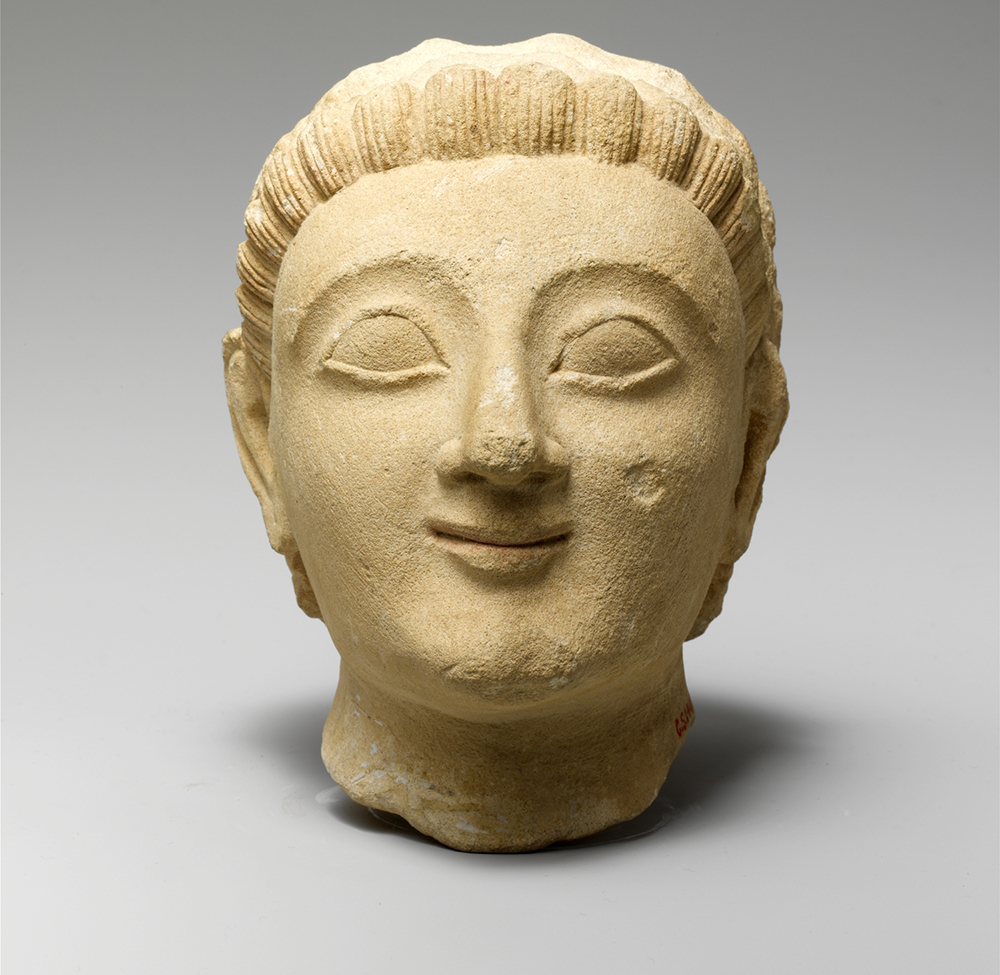
Limestone head, c. 525 bc. The Metropolitan Museum of Art, The Cesnola Collection, Purchased by subscription, 1874–76.
By 2019 much of this “nonsense” has been adopted, if often in significantly revised and sanitized form, by the West, which has leveraged ancient Indian practices into an estimated $4.2 trillion industry that lumps yoga, meditation, breathing practices, and Ayurvedic medicine into the nebulous category of mindfulness. This has not gone unnoticed by Modi, who operates under the nationalist slogan india first. Two years before the Happiness Ministry was announced, Modi launched a “Make in India” campaign that attempted to officially market some of these practices, including yoga, as a UNESCO-protected Indian heritage. “Yoga,” Modi later announced before the UN General Assembly, “is India’s gift to the world.”
But none of this history helped make the institutional efforts of the political ministry succeed. A little over a year into the Ministry of Happiness’ existence, a strange incident occurred: Lal Singh Arya, the ministry’s director, went missing. It quickly became clear that he was not actually missing but in hiding, and soon a statewide manhunt was underway for his arrest. Police in Madhya Pradesh accused him of having ordered the killing of political opposition leader Makhanlal Jatav back in 2009. Jatav, who belonged to the rival Congress Party, had been out campaigning for the upcoming election when an “unknown assailant” shot him twice in the temple at close range. It was not entirely clear why, eight years later, Arya was suddenly being accused of the murder, but his disappearance was not encouraging to his case for innocence.
It was somehow fitting, then, that the year the Happiness Ministry launched its first programs in Madhya Pradesh was bookended by desperate crises in the state. There were severe droughts that destroyed crops, and some 1,321 farmers committed suicide; vicious flooding ravished 2,300 homes and killed twenty people. That same year scientists discovered that an all-time high of thirty-one tigers had mysteriously died in the state’s sanctuaries. Violence against women, too, was hovering around dangerous levels. The Hindustan Times reported one woman was raped almost every two hours in Madhya Pradesh that year.
By the time Arya mysteriously reemerged from hiding, the very existence of the Happiness Ministry seemed like a pithy mockery of politics. Arya denied any involvement in Jatav’s murder (though his trial is ongoing). Meanwhile, the ministry was phased out in 2018, folded by the BJP government into the Ministry of Religion, and then further condensed into a Spiritualism Department, whose tasks included, among other things, a “cleanliness mission” and “preventing embryo killings.” What any of that was going to look like, however, nobody would ever know. This past December, after a fifteen-year ruling streak in Madhya Pradesh, the BJP lost elections in the state to the newest ruling party, the Indian National Congress.
The BJP’s attempts to project Indian happiness as part of its nationalist mission had failed to take hold before its fall from power in Madhya Pradesh. Its ministry had failed on multiple accounts: first in giving an impression to the world of a happier state, second in actually alleviating any distress. It had not, by anyone’s account, ever really helped anyone.
It was unclear, then, what to make of an announcement made last summer by the municipal government of Delhi that it was planning to initiate its own “Happiness Curriculum” in every public school across the city. The curriculum was not being launched by Modi’s BJP but by its bitter rival, the Aam Aadmi Party, a progressive grassroots party that had engineered a shocking defeat of the BJP in Delhi in 2015. It seemed possible it was little more than just a political taunt.
But the new happiness curriculum has, so far, tread a very different path from the ministry. Last July it was rolled out as planned, spreading its tentacles to a thousand public schools, twenty thousand teachers, and, according to one generous estimate, a million families. His Holiness the Dalai Lama, who’d been an adviser for the curriculum, traveled to New Delhi for the program’s launch. “Modern education focuses on material values and has nothing to offer regarding inner peace,” he said at its launch. “Only India has the ability to combine modern education with ancient knowledge.”
Just to fill the hour—that is happiness.
If the BJP’s ministry sounded like a grandiose and nebulous way to rehabilitate India’s ancient wellness practices, this new initiative was far more practical. For one thing, its director was not another ambiguously tasked happiness minister but Delhi’s actual education minister, the forty-seven-year-old Manish Sisodia. When I spoke with Sisodia last February, he struck me as an unusual visionary: a former journalist who became an activist and then a teacher and whose Twitter bio states, “I like Gandhi, because he always moved ahead of his own identity.” He admitted to me he was an “optimist,” and he spoke like one. When he was appointed education minister, in 2015, he was determined to breathe new life into Delhi’s school system. He had spent years asking himself what the purpose of education was: To prepare students for strong, successful careers? To help them earn a livelihood? To gain knowledge for a degree? Or was it for something else entirely?
In September 2017, Sisodia attended a three-day international education conference in Moscow. Representatives from forty other countries congregated to discuss the future of global education. Each talked about the new technologies being used in classrooms, the innovative ways in which they were training teachers. When Sisodia took to the platform, he gave an impassioned speech. “I come from the homeland of the world’s best IT professionals,” he said. “But let me tell you, I also come from the homeland of premier studies in emotional science. We need to stop talking about new technologies; technology is not going to stop violence. I assure you, we the education makers of the world, we can stop this through education.” After his speech, heads of education from Afghanistan, Russia, and Nepal approached him to say: It’s a nice idea, but how?
When we spoke, Sisodia clarified his thoughts. No government can directly bring happiness to someone, but a government can be responsible for something else: providing its population with the tools to reach their own inner strength. “The purpose of education is to give students the skills to live a happy life, whatever they do in life, and to enable others to do the same,” Sisodia explained. He was dressed in a red wool sweater, the trace of a smile etched permanently on his face, and he gave off the faint air of an unveiled Santa Claus. Happiness comes from shakti, he explained, a cosmic energy that enables one’s power, ability, strength, effort, and capabilities. That’s what he wanted his happiness curriculum to do, for every student in Delhi. When I asked him how this would work, he provided an example, an Aesop’s fable of sorts: A man is walking past a construction site, and after seeing three laborers at work, he asks them what they are doing. The first replies he is crushing stones because he was told to. The second replies he is crushing stones so he can feed his family. The third, however, replies he is crushing stones to help build a school for the community. “Everyone passes through these three states of mind in their daily lives,” Sisodia explained. “The point of the happiness class is to narrate the bigger picture.”
When I was in New Delhi in late April, I sat in on a happiness class in the center of the city at an old schoolhouse where students wore uniforms of white collared shirts tucked into blue pants. A fan spun lethargically above our heads, pushing around the 107-degree heat leaking in through the cracks in the windows. A hand-painted sign hung from a chalkboard at the front of the classroom, reading in English: born free, live free.
“Listen up now, everyone sit up straight,” a young teacher in an elegant black-and-gold sari began. “No tension in your minds or body. Inhale the fresh air, breathe out. Slowly close your eyes.” It was early in the morning, and the promise of the coming summer break hung in the air. “Try to listen to the surrounding sounds from the environment. If thoughts are coming in your mind, neglect. Deep breaths. Relax.” I closed my eyes along with the students. For a few minutes the room fell totally still, the cacophony of Delhi’s blasting horns a world away. When we opened our eyes, the teacher asked everyone to explain what they had heard. Arms shot into the air. “I heard children shouting and playing outside,” a young boy said, standing up. The room applauded him for speaking. “I heard my friend breathing,” another said.
We were asked to close our eyes again, this time to try and block out the outside world entirely. “Take in the fresh air, feel it touch your lungs, your muscles, ujjayi [victorious] breaths.” In unison, a few minutes later, everyone opened their eyes, as the teacher told us, in Hindi, to slowly take in the colors of the room, the tension in our muscles, the soft murmur of our breaths. Then an “activity” began. The teacher etched out a four-squared grid on the chalkboard, filled in through call and response. What looks good but isn’t good? “Watching TV,” one boy said. What does not look good but is good? “School,” said another. What you don’t like and isn’t good? “Litter.” What you like and is good? “Milk,” one answered. “Roaming here and there,” said another.
The Madhya Pradesh ministry had employed images of smiling kids for its PR efforts, but there’s a difference between giving children a joyful day of games and training them to have useful tools to address future problems. “Our education system produces doctors, engineers, lawyers, but is it able to produce or nurture the right human beings?” Manu Gulati, a teacher in Delhi who helped work on the curriculum, explained to me. “Schools aren’t providing the right education. The genesis of the happiness curriculum is focusing on the being of a person, not the parameters of success.”
While it is tempting to view the various installations of happiness curricula with a cynical eye—a snake-eats-tail charade where a government claims to be curing unhappy inclinations at the same time its policies often cause that very unhappiness—the successor to the Happiness Ministry in Delhi offers at least the suggestion of a more promising path. For Sisodia, the potential of the program is to leverage India’s collective wisdom, both scientific and otherwise, to furnish students with some of these ancient practices. Both the East and the West have been consumed with studying energy for more than four hundred years, he explained to me. To the West, this meant understanding the atomic structure—how protons, neutrons, and electrons made up the energy of an atom. To Indian scientists, studying energy was an emotional science, a study of the inner life. “India’s scientists actually discovered zero, or sunya,” he said. “What is sunya? It’s energy, the space around us, within. This entire curriculum is inspired by Indian gurus who helped work on emotional science.”

Wine-drinking scene, detail of a hand-painted rumal, India, c. 1640. The Metropolitan Museum of Art, Rogers Fund, 1928.
Despite the attempts of the World Happiness Index to raise awareness of practices that make us happy, there is still little emphasis today, at least in the political realm, on “emotional science.” But maybe that will change. With the happiness curriculum in its second year, the idea is catching on both domestically and abroad. Other states in India, such as Andhra Pradesh and Maharashtra, are in the process of implementing similar curricula in schools across their state. Then, last October, the Afghan education minister announced that Afghanistan would be installing its own version of a happiness curriculum—a particular challenge in a country where the Taliban has tried to ban modern schooling in favor of madrassas. And earlier this year, the British government added a “mindfulness” curriculum to 370 schools in England—a way, it announced, to “regulate emotions.”
In spite of the curriculum’s success—even though yet another idea from India had begun to spread around the world—India’s ranking in the World Happiness Index continues to slip. February of this year saw the worst escalation of attacks between India and Pakistan over Kashmir since the last war. “Surgical strikes” were fired, an air pilot was held hostage and then released, and media uproar raged against Pakistani “terrorists.” When the World Happiness Report was released one month later, India’s ranking was the lowest it had ever been: 140 out of 156.
The news did not seem to astound anyone. The government had not protected Indians from hunger and drought. It had not brought them health care. And it had not stopped, in the last three years, murderous Hindu cow vigilantes from attacking Muslims with clubs and gasoline, killing at least forty-four people. It had started a curriculum whose effects will be known only a generation later; it had launched a ministry to boost national pride, and then ended it after delivering on none of its goals, not even in appearing superior to its rivals. When the 2019 happiness rankings came out in March, Indian headlines reported: pakistanis are happier than indians.
Related Reads
'다시 읽고싶은 글' 카테고리의 다른 글
| Why can’t we agree on what’s true any more? (0) | 2019.09.21 |
|---|---|
| Happiness: The Impossible Dream (0) | 2019.08.25 |
| After Epstein, Our Elites Must Reform or Face the Fire (0) | 2019.08.14 |
| A Cultural Agenda for Our Time (0) | 2019.07.21 |
| Hell Breaks Loose (0) | 2019.07.01 |

